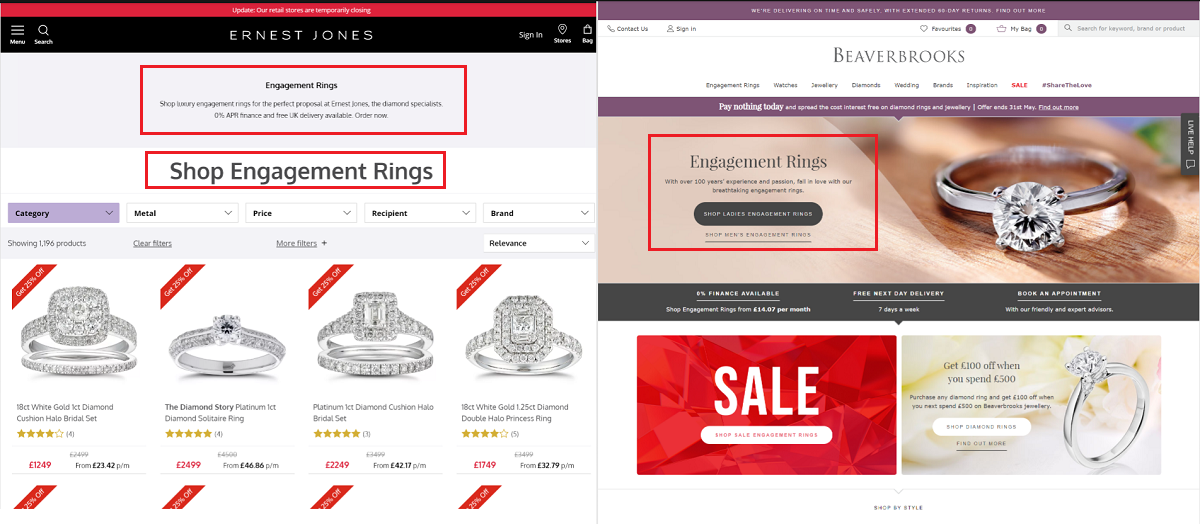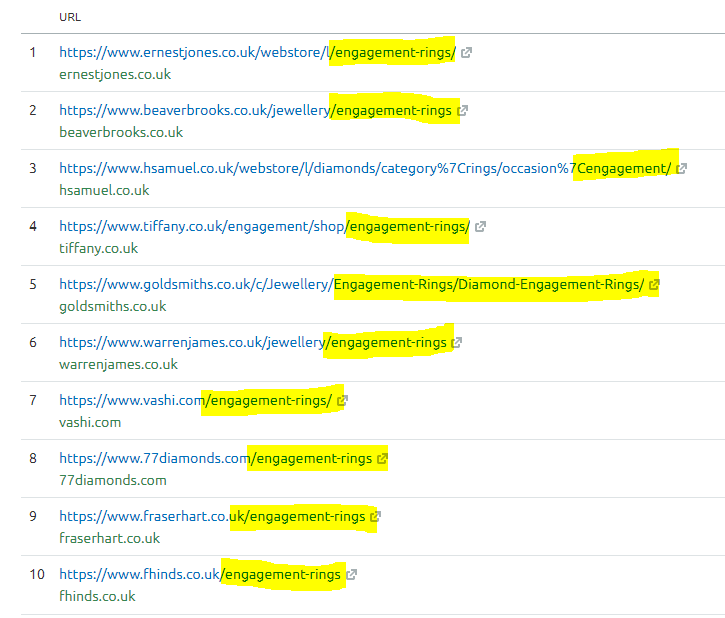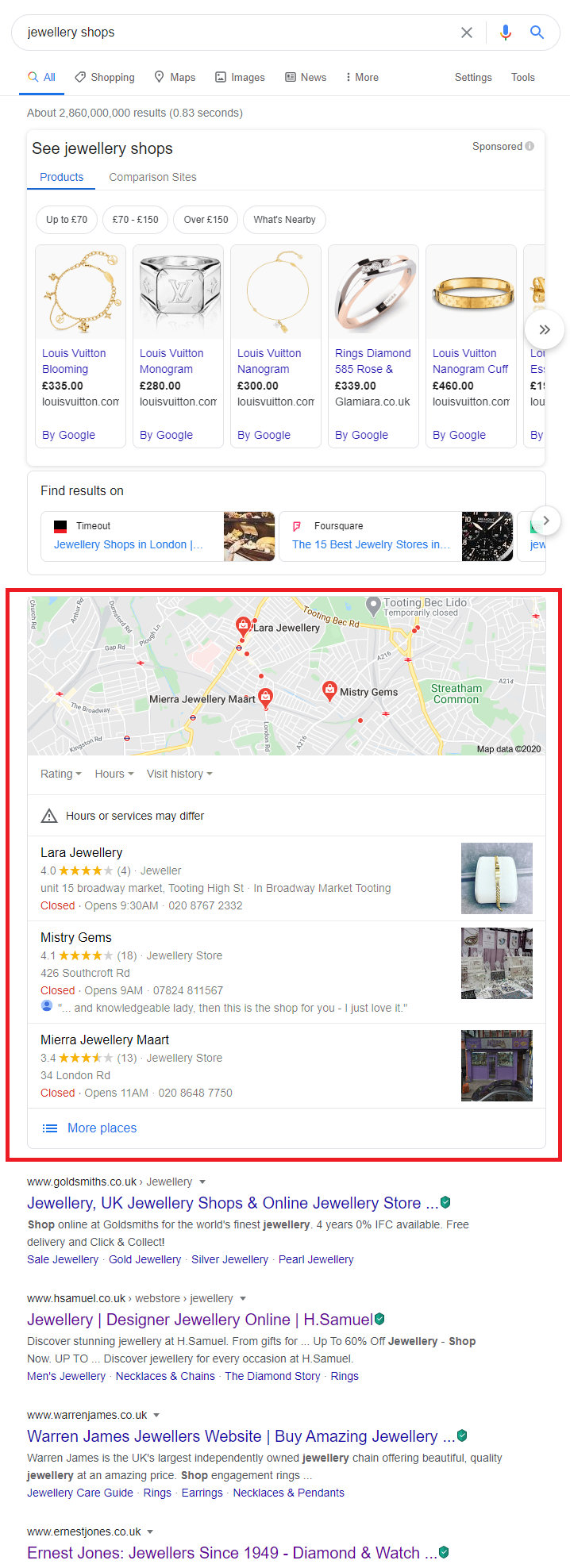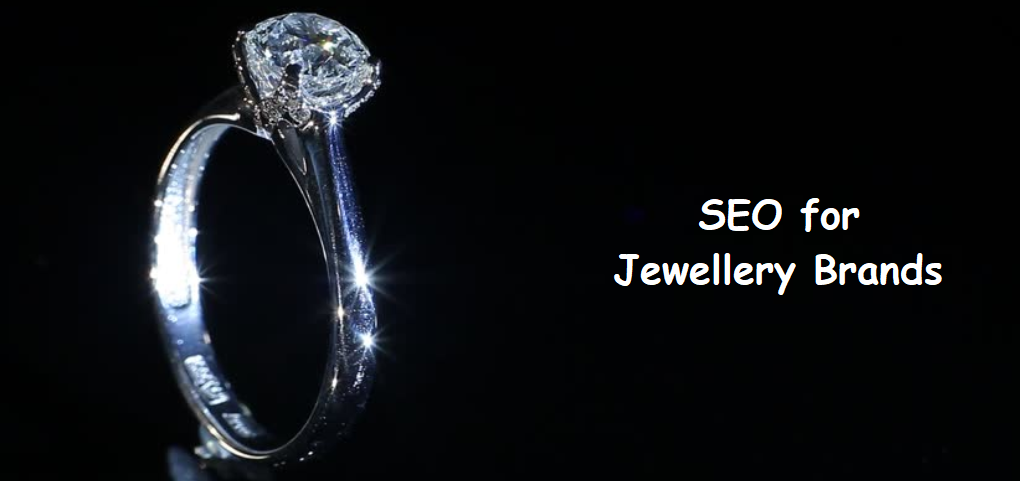The jewellery industry is one of the most challenging markets within the UK, with a whole host of brands competing for market share online. In the UK, the organic SERPs in the jewellery industry are dominated by these 6 brands – diamondsfactory.co.uk, ernestjones.co.uk, tiffany.co.uk, beaverbrooks.co.uk, warrenjames.co.uk and queensmith.co.uk. Below is the Sistrix SEO visibility trend graph over the last 1 year (last updated on February 1 2025), comparing the top 6 online jewellery specialists by organic visibility.

The biggest challenge for multi-brand jewellery retailers is how they stand out in the jewellery sector compared to their competition when selling largely the same jewellery brands.
The objective of this Jewellery SEO guide is to;
- Drive traffic and increase revenue from your online jewellery store.
- Improve rankings in SERPs for target keywords to drive relevant traffic.
- Increase the number of enquiries and increase footfall to your physical store via local SEO.
Before you read this jewellery SEO guide, consider which variation you aim to improve visibility for. Is it “jewelry” / “jewellery”? Confused :-)? Both “jewelry” and “jewellery” are correct. Optimise for jewellery (British English) keyword variations if your target market is the UK. If your target market is the USA, optimise for jewelry (American English) keyword variations. But you could use both interchangeably as they don’t differ in meaning. For this guide, I’ll be referring to the spelling ‘jewellery’ since I am based in the UK.
The Jewellery SERP Landscape
When it comes to SEO in the jewellery industry, there’s much more to it than just optimising the traditional blue links in the SERPs. When you perform searches for terms containing jewellery products, the most common SERP features that show up are;
- Adwords top & bottom and Shopping ads.
- Local pack results
- Featured snippets
- Organic Shopping Listings
- Site links
- People also ask
- Knowledge panels
- Image results / Video results / Image packs / Video carousels
- Featured video
With the constant changes in the SERP landscape, Jewellers and Jewellery Brands need to step up their marketing game to stand out from the rest across the variety of SERP features to reach and capture their target audience. Read along to follow how to improve the jewellery business SEO.
SEO Strategy for Jewellery Stores
Since jewellery is one of the most competitive markets, it will take a good SEO strategy to steal market share from the Big 4. Let’s look at the SEO best practices that jewellery website owners can take action on for their sites.
- Jewellery Keyword Research
- Site Structure & Navigation
- Optimise your Page titles and Meta descriptions
- Optimise Product Category Content
- Optimise Product Description Content
- Optimise Site URLs to include target keywords
- Set up a Jewellery Blog
- Local SEO for Jewellery Stores
- Link Building Strategy
- Technical Site Audit
- Page Speed & Mobile Friendly
- Set up Google Analytics & Search Console
Jewellery Keyword Research
Keyword research is the backbone of an SEO strategy. Investing time in thorough keyword research will help identify the jewellery keywords the brand needs to optimise and be visible for. The most popular product offerings in the Jewellery e-commerce business are eye-catching engagement rings, wedding and eternity rings, necklaces, bracelets, earrings and pendants made of diamonds and other precious gemstones.
Jewellery Keywords – Top 50
I have listed below the top 50 most popular non-branded keywords in the Jewellery industry.
| Keyword | Avg. Monthly Searches |
|---|---|
| engagement rings | 165000 |
| jewellery | 110000 |
| vivienne westwood necklace | 49500 |
| engagement ring | 40500 |
| wedding rings | 40500 |
| ring size chart | 40500 |
| bracelet | 40500 |
| necklace | 40500 |
| eternity ring | 33100 |
| gold earrings | 33100 |
| gold necklace | 33100 |
| diamond ring | 27100 |
| tennis bracelet | 27100 |
| pearl necklace | 27100 |
| vivienne westwood earrings | 27100 |
| gold bracelet for women | 22200 |
| mens bracelet | 22200 |
| gold bracelet | 22200 |
| mens rings | 22200 |
| december birthstone | 22200 |
| diamond earrings | 18100 |
| moissanite | 18100 |
| gold jewellery | 18100 |
| gold hoop earrings | 18100 |
| november birthstone | 18100 |
| earrings for women | 18100 |
| clover bracelet | 18100 |
| ring sizes | 18100 |
| wedding ring | 14800 |
| mens wedding rings | 14800 |
| mens jewellery | 14800 |
| silver bracelet for women | 14800 |
| necklace for women | 14800 |
| diamond rings | 12100 |
| engagement rings uk | 12100 |
| diamond necklace | 12100 |
| wedding bands | 12100 |
| gold bangle | 12100 |
| gold bangles | 12100 |
| gold necklace for women | 12100 |
| ring size chart uk | 12100 |
| bracelets for women | 12100 |
| bracelet for women | 12100 |
| hoop earrings | 12100 |
| engagement rings for women | 9900 |
| emerald ring | 9900 |
| gucci earrings | 9900 |
| gold bracelets for women | 9900 |
| wedding rings for women | 8100 |
| sapphire ring | 8100 |
Utilising specialised keyword research tools such as Ahrefs, SEMrush, or Google Keyword Planner can help identify high search demand keywords with manageable competition levels.
Site Structure & Navigation
A clear, well-organised site structure is essential for jewellery websites, which often include a wide range of categories, collections, product pages, and informational content. A logical hierarchy improves both user experience and search engine crawlability.
Use faceted navigation to group products by key attributes such as Style, Metal, Gemstone, Shape, Carat, Setting Type, Price, Gender, and Occasion, making it easier for users to browse and for search engines to index.
Strategic internal linking between related products, blog posts, and category pages helps strengthen topical relevance and distribute link equity across the site. Connecting categories, subcategories, and related content supports site architecture and improves SEO performance.
Finally, ensure your page titles, headings (H1-H3), and on-page content are aligned with targeted keywords. Well-structured content on category pages placed prominently can have a strong impact on search visibility.
Optimise your Page titles and Meta descriptions
Notice the SERP below you will be presented with when you search for “engagement rings”. All the page titles use the head term “engagement rings” which tells Google (and users) what the page is about.

The meta descriptions below the title also target your primary and secondary keywords. Writing a meaningful meta description is important to explain to your potential customers what your page is about. They are not a ranking factor, however, they affect your CTR. As with the title tags, no specific number of characters exists for an optimal meta description length. It is recommended to keep your descriptions under 160 characters.
Optimise Product Category Content
The content of your page needs to relate to your page title and your keywords. Optimise your page heading tags and on-page copy to target keywords. Check out the examples below with both sites placing their category copy at the top of the page. Ensure the category content is reviewed based on seasonality and updated to make it relevant. A well-structured category page would also include internal links to sub-categories or other related categories via their copy.

It is not uncommon to see luxury brands place category copy at the bottom of the page below the product grid.
Optimise Product Description Pages
Product pages serve as the heart of jewelry e-commerce sites and require thorough optimisation to perform effectively in search both in traditional search listings and organic shopping listings. Each product page should include clear, descriptive product titles that incorporate relevant keywords while accurately describing the item, such as “Platinum 1ct Diamond Round Cut Four Claw Solitaire Ring” rather than generic product codes or vague descriptions. This detail helps both search engines and customers understand exactly what’s being offered.
Product descriptions should be detailed and unique, highlighting diamond details such as stone type, shape, carat size, clarity, colour, certificate information, ring design, materials, craftsmanship, special features and more. Generic manufacturer descriptions should be avoided in favour of original content that addresses potential customer questions and incorporates relevant keywords naturally.
High-quality product images are essential for jewellery items, but they must be properly optimised with descriptive file names, compressed file sizes for faster loading, and image alt text that describes the product for both accessibility and SEO benefits. Include multiple angles of your jewellery photos on your product description pages. Show the jewellery product in a 360-degree spin to give your customers a near-buying experience from a big shopping centre.
Additionally, implementing structured data markup on product pages can improve visibility in rich results and provide additional information directly in search results. For jewellery products, schema markup can highlight crucial details like price, availability, reviews, and product specifications in the SERPs, potentially improving click-through rates.
For jewelry businesses, Product, Organization, and LocalBusiness schema types are particularly relevant and should be implemented according to current best practices.
Optimise Site URLs to include target keywords
Using keywords within your URL not only makes the URL clear and human-readable but is also a minor ranking factor. For all the top 10 URLs ranking for the term ‘engagement rings’ on Google, use the head term within the URL to reflect the content of the brand categories.

Set up a Jewellery Blog
Blogs represent a valuable asset for jewelry retailers looking to improve SEO performance.
The vast majority of jewellery customers spend hours researching a jewellery purchase before they walk into a jewellery store or purchase jewellery online. The key to your blog is to convert these researchers into online buyers. Publishing helpful, informative content allows brands to target informational queries, demonstrate EEAT and naturally incorporate keywords that might not fit on product pages.
Luxury brands can do this by creating a blog to build a brand persona and giving their potential customers better access to new and relevant content to help them with the decision to purchase their jewellery. Use your blog content to showcase your products and target long-tail keywords (low-hanging fruit) to build topical authority and drive incremental organic traffic to the site.
Each blog post should include internal links to relevant product or category pages, creating natural pathways for readers to move from informational content to products.
Jewellery blog content ideas
When developing blog content, jewellery brands should focus on topics that answer common customer questions or provide inspiration, such as;
- Evergreen buying guides. Example: H.Samuel Jewellers and Ernest Jones create in-depth buying guides for their core products and link to them from the footer.
- Care guides such as “How to Care for Your Engagement Rings
- Luxury Gift posts ideas around key calendar events such as Valentine’s Day, Mother’s Day, etc, to target gift search queries.
- Product style advice and inspiration posts.
- Jewellery gift recommendations for various occasions, such as “Gift Guide: Perfect Jewellery Gift for Valentine’s Day”.
- Latest collection/product launches posts. These trend posts usually gain backlinks from publications or bloggers. Trend posts such as “Top Jewellery Trends for 2025”
- How-to articles and other answer-based informative posts to showcase your industry expertise. Here’s a quick snapshot using the SEMRush keyword magic tool to view the questions people ask on Google related to engagement rings.

Well-structured, informative blog posts that answer specific customer questions also have the potential to appear in featured snippets or Google’s AI Overviews, helping boost your Jewellery brand’s visibility in search results and reinforcing topical authority.
Local SEO for Jewellery Stores
For jewellery retailers with physical locations, local SEO represents an important opportunity to attract nearby customers actively searching for jewellery products and services. Implementing strong local SEO strategies can increase visibility for high-value local searches like “jewellery shops near me” or “jewellers near me,” which collectively account for thousands of monthly searches.
Local SEO helps you to target customers searching within a specific geolocation. If you manage to rank locally, your jewellery business will be occupying the prime spots within the Google SERP, i.e. the top 3 search results within the local pack/knowledge panel.

I have listed the top 5 non-brand jewellery local searches made on Google UK. To get listed on Google’s local pack or maps results for these search queries, first and foremost, you need to set up a Google Business account. Setting up an account is fairly straightforward. I have written a Local SEO guide to optimise your Google Business Profile to rank higher for local map searches as well as general search results.
| Local Keywords | Avg. monthly searches |
|---|---|
| jewellery shops | 27100 |
| jewellers near me | 18100 |
| jewellery stores | 18100 |
| jewellery shop near me | 9900 |
| jewellery stores near me | 2400 |
For optimal results, jewellery store owners should ensure their Google Business Profile is fully completed with accurate business information, including name, address, and phone number (NAP). Adding high-quality images of both the store interior and product offerings can improve engagement, while regularly updating business hours, especially around holidays, maintains accuracy.
Encourage customers to leave reviews and respond promptly to both positive and negative feedback to build trust with potential customers. This engagement signals to Google that your business is active and responsive, potentially improving local rankings.
Local Keyword Targeting
Optimise your Jewellery location landing pages with area-specific keywords in business descriptions and content to further improve local visibility for geo-targeted searches.

Check out this London-based store page from Diamond Factory that includes comprehensive information about the store’s offerings, location information, opening hours and more that demonstrate local relevance to both users and search engines.
Local Citations and Directory Listings
Beyond Google Business Profile, jewelry stores should establish a consistent presence across various maps platforms and local citation directories. Important platforms include Google Maps, Bing Places, Apple Maps, Facebook, Yell, Yelp, and Thomson Local, among others. This expanded presence strengthens local SEO signals while providing multiple touchpoints for potential customers to discover the business.
Don’t Overlook Structured Data
To further support your local SEO efforts, implement relevant schema markup on your site. For jewellery businesses, the Organization and LocalBusiness schema markups are useful. Adding this structured data helps search engines better understand your business and physical presence.
Ensure that your NAP and Opening Hours always remain consistent on all platforms, especially on your website, maps and directory listings.
Link Building Strategy
In this section, I’ll show you a few examples of link-building tactics used by popular Jewellery websites to gain authoritative backlinks. The link-building strategy needs to be on getting quality and relevant inbound links to improve your site’s authority & SEO visibility. If you have well-written informative guides, innovative products, interesting features or new product launches, people will want to link to them.
My recommendation would be to work closely with your digital PR team to raise brand awareness to drive sales for your brand. Your PR team will already have longstanding media relationships with the UK national, broadcast, regional and trade press – both print and online. So leverage them to structure your PR activity around an ‘Always-on’ press activity to reach key target media, outlets and gift guides. Your brand can also benefit from creating high-impact creative campaigns.
- Lifestyle magazine sites that typically cover fashion, beauty, health and entertainment. The new collection often gets picked up by press sites or magazines. The coverage on these sites typically includes product placement that will tie into popular times for buying jewellery, such as Christmas & New Year, Valentine’s Day, Mother’s Day, Father’s Day, etc. Key gifting occasions such as 18th and 21st birthdays, weddings and giving birth are popular when consumers are looking for this sort of product placement coverage for their collection.
- https://www.elle.com/uk/fashion/what-to-wear/articles/g31918/best-watches-to-buy-this-season/
- https://www.cosmopolitan.com/uk/fashion/a37540/different-engagement-ring-shapes-cuts/
- https://www.marieclaire.co.uk/fashion/shopping/christmas-gifts-for-him-77052
- https://www.esquire.com/uk/style/g22819347/best-mens-signet-rings/
- https://www.hitched.co.uk/wedding-planning/organising-and-planning/the-complete-wedding-anniversary-guide/
- https://www.harpersbazaar.com/uk/bazaar-brides/a20757742/meghan-markle-feminism-royal-wedding/
- https://www.parents.com/pregnancy/my-life/preparing-for-baby/amazing-push-gifts/
- https://www.vogue.co.uk/arts-and-lifestyle/article/where-the-vogue-editors-are-spending-christmas
- https://bridalmusings.com/63814/ultimate-guide-gemstones-diamond-alternatives-engagement-rings/
- https://fashionmagazine.com/style/jewellery/bold-earrings-for-your-next-video-conference-call/
- https://www.designboom.com/competition/crystal-vision/
- https://www.elizabethannedesigns.com/blog/2013/01/30/pink-babys-breath-wedding/
- Fashion/trend websites
- https://www.fashionbeans.com/article/mans-guide-to-wearing-rings/
- https://www.teenvogue.com/story/issa-rae-april-2020
- https://www.highsnobiety.com/p/shopping-raven-smith-xmas/
- https://www.wonderslist.com/top-10-fashion-brands-of-the-world/
- https://www.whowhatwear.co.uk/average-engagement-ring-size
- Jewellery sites: Placing expert comments from your Jewellery brand’s spokesperson in national newspapers and online jewellery sites will get good exposure for your target audience.
- http://www.jewelrywise.com/
- https://www.engagementringbible.com/engagement-traditions-and-origin/
- http://www.thejewelleryeditor.com/jewellery/article/history-of-pearls-pearl-jewellery-rings-earrings-necklaces/
- http://engagementrings.life/
- http://www.thejewelleryeditor.com/jewellery/article/the-history-of-tiffany-tiffanys/
- Press releases or Newspaper site mentions Communicating key business updates to the media, such as sales increases, indicating new trends, new product offerings, new store openings, business announcements & key milestones newsjacking is a good way to increase brand awareness and get coverage.
- https://www.thesun.co.uk/fabulous/8726968/h-samuel-is-selling-disney-engagement-rings-and-theyre-inspired-by-frozen-cinderella-and-beauty-and-the-beast/
- https://www.theguardian.com/business/2019/oct/28/luxury-goods-group-lvmh-in-tiffany-takeover-talks
- https://www.telegraph.co.uk/luxury/jewellery/best-weddings-rings-how-choose-perfect-band-platinum-gold-traditional/
- https://theconversation.com/what-is-kawaii-and-why-did-the-world-fall-for-the-cult-of-cute-67187
- Event Sponsors
- https://www.kitzalpbike.at/
- https://www.worldsummitawards.org/wsa-global-congress-2020-vienna/
- https://designmuseum.org/exhibitions/louis-kahn-the-power-of-architecture
- Travel Magazine sites
- https://www.nytimes.com/interactive/2016/01/07/travel/places-to-visit.html
- https://www.jenreviews.com/best-things-to-do-in-austria/
- https://www.cntraveller.com/gallery/worlds-most-influential-women-travellers
- https://www.visitlondon.com/things-to-do/shopping/top-shopping-destinations
- And several fashion bloggers’ sites, such as http://www.emilylavenders.com/ and http://www.splashofteal.com/ have already mentioned jewellery brands.
Use tools like SEMRush or Ahrefs to look at your competitor’s backlinks and see if you can get links from them. Tools like the Link Intersect tool on Ahrefs can be useful to compare your link profile versus the competition.
Look for competitor backlinks with a strong DA to add to your link outreach list. Studies have shown a positive correlation between DA and website rankings.
Technical Site Audit
Performing regular technical SEO audits can give you actionable insights on the non-compliant issues of your site that would need resolving. Technical SEO fixes can have a significant positive impact on your SEO performance. The tools I recommend to include in your arsenal are ScreamingFrog and any of these larger tech SEO enterprise tools, such as Botify / Deepcrawl / Sitebulb / OnCrawl. You could even check the new and improved crawl stats for your site within the search console to find issues.
Page Speed & Mobile Friendly
Mobile optimisation is essential for jewellery e-commerce sites, with a large share of searches now happening on mobile devices. Responsive design that delivers a smooth browsing and shopping experience across all screen sizes is key. In addition to responsiveness, mobile optimisation should focus on fast load times, intuitive navigation with touch-friendly features, a streamlined checkout process, and high-quality product images that render well on smaller screens.
Site Speed is especially critical, as delays affect both user experience and conversion rates. This is especially important for jewellery websites, where high-resolution product imagery is essential. Optimising for speed without compromising visual quality involves using techniques such as image compression, efficient coding practices, browser caching, and content delivery networks (CDNs). Regular testing across different devices and browsers ensures a consistent and seamless user experience.
Make sure your site is mobile-friendly, fast, and secure. To assess performance, run a visual comparison test on webpagetest.org to see which of the top four jewellery retailers has the fastest performance.
Set up Google Analytics & Search Console
You are probably aware by now that the impact of SEO changes doesn’t happen overnight. You will start seeing positive results in a couple of weeks if done right. Setting up a Google search console & analytics can be useful to inspect your site health, crawl errors, review indexation, sitemap errors, organic performance, etc.
Conclusion
With rising competition in jewellery search, a well-rounded SEO strategy is more important than ever. Success lies in combining technical best practices with jewellery-specific tactics that reflect the unique nature of the industry. By treating SEO as an ongoing effort, not a one-off task, jewellery brands can boost visibility, stay ahead of algorithm changes, and drive long-term growth through organic search in 2025.
No time to deal with Jewellery business SEO? I provide Jewellery website SEO services. Contact me today to discuss how I could help.


I would be interested on what you can do on my website for my business. Let me know. Do a audit and send me what can be done and what is missing.